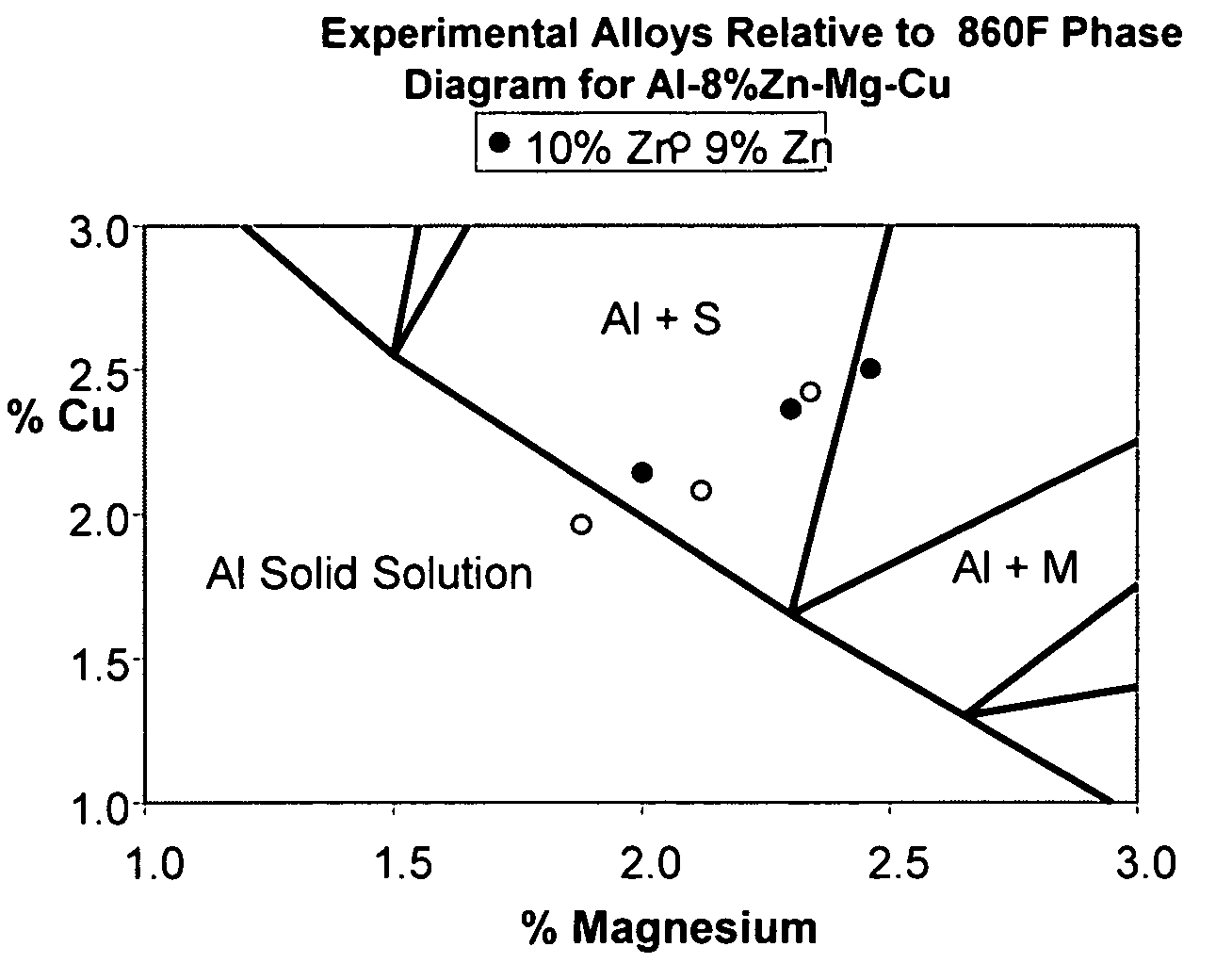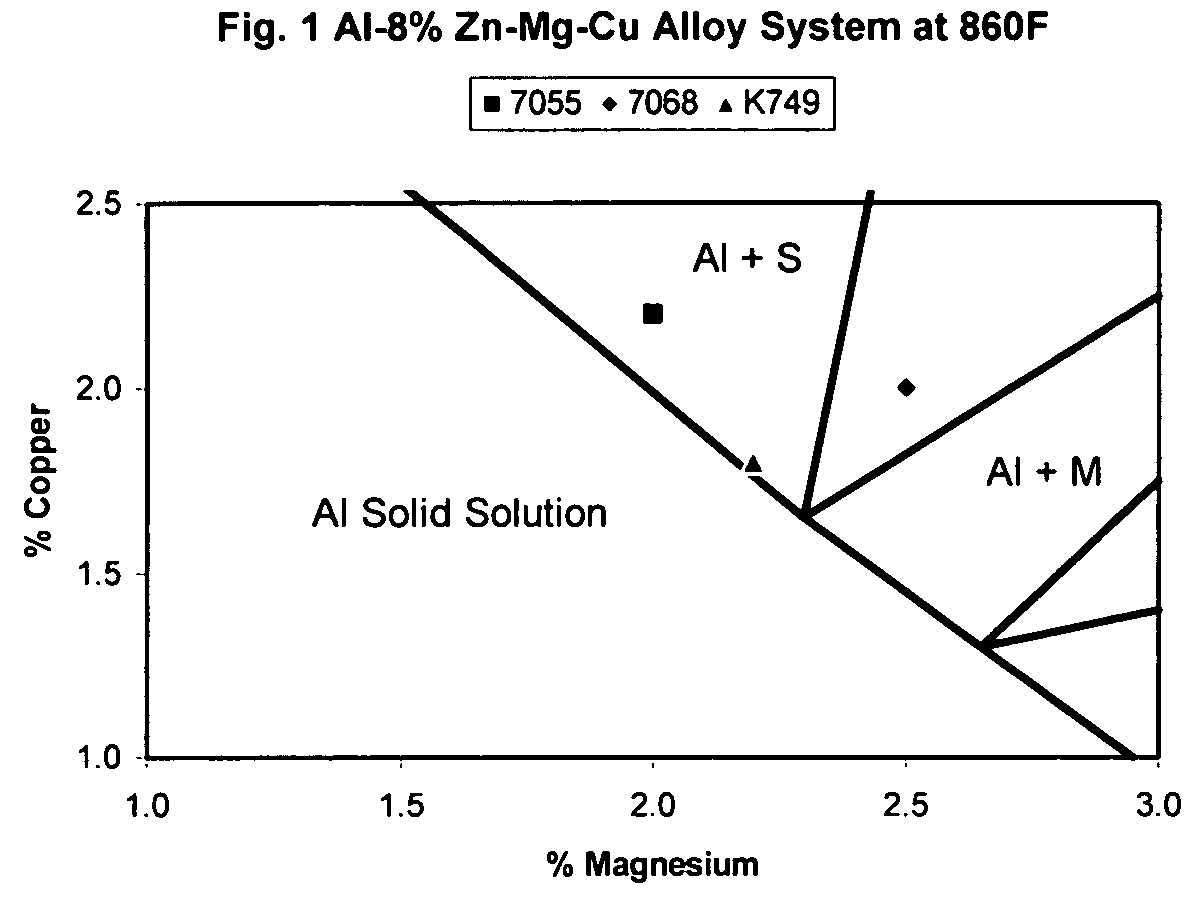High strength aluminum alloys and process for making the same
a technology process, which is applied in the field of high-strength aluminum alloy, can solve the problems of reducing toughness and reducing toughness of undissolved phases after heat treatment, and achieves the effects of reducing the amount of low melting point eutectic phases, and reducing the amount of undissolved phases
- Summary
- Abstract
- Description
- Claims
- Application Information
AI Technical Summary
Benefits of technology
Problems solved by technology
Method used
Image
Examples
example 1
[0021] The alloy compositions listed in Table 1 were cast as 9″ billet, most of which contained a relatively high nominal zinc content of 9%.
TABLE 1% by wt. (Spectrographic analysis)Alloy No.SiFeCuMgZnZrSc450.020.041.412.577.960.120.053360.030.061.912.179.020.150.054390.040.051.282.749.020.130.059430.030.031.442.559.040.130.053470.040.061.592.348.950.140.055
[0022] These alloys are depicted on the 860° F. (F=degrees Fahrenheit) phase diagram in FIG. 2 together with a K749 “control” containing nominally 8% Zn. Note that all of these alloys contain about 0.05% scandium, an element which in combination with zirconium is effective in preventing recrystallization.
[0023] The billets were homogenized at 880° F. and extruded to seamless tubes 4″ in diameter with a 0.305″ wall thickness. After sections of the extrusions were cut and flattened to pieces about 12″ square, they were solution heat treated at 880° F. and quenched in cold water. They were then tested for tensile properties and f...
example 2
[0025] Another alloy similar to #36, except for a 0.11% Sc content (9.22% Zn—2.14% Mg—1.88% Cu) was prepared and likewise extruded to a 4″ diameter tube with a 0.305″ wall thickness. Tubes of this alloy together with K749 and #36 (both with 0.05% Sc) were subsequently cold drawn to a diameter of 2.25″ and a 0.10″ wall thickness. After solution heat treating and aging, longitudinal yield strengths were measured with the results in Table 3.
TABLE 3YieldStrengthAlloyCuMgZnSc(ksi)K7491.982.188.020.050 99.3361.912.179.020.054103.3371.882.149.220.107104.0
[0026] Note that the experimental alloys with the higher zinc concentrations again were significantly stronger than the K749 alloy with 8% Zn. Also, noteworthy is the fact that both alloys containing 0.05% Sc maintained much higher strength levels after the cold drawing operation than was evident in the as-extruded condition (compare with previous table). In other words, as little as 0.05% Sc was sufficient to prevent recrystallization d...
example 3
[0027] It has been recognized for a number of years that scandium in combination with zirconium is an effective recrystallization inhibitor. A Russian review article noted that it is desirable to add scandium to aluminum alloys in a quantity from 0.1 to 0.3% together with zirconium (0.05-0.15%). However, the greatest effect is observed for alloys not containing alloy elements combining with scandium in insoluble phases; with a limited copper content [scandium combines with copper] alloying with scandium together with zirconium of Al—Zn—Mg—Cu and Al—Cu—Li alloys is possible. As such, commercial alloys based on Al—Zn—Mg—Sc—Zr have been developed.
[0028] Two potential drawbacks to scandium additions to 7XXX alloys containing about 2% copper are evident:
[0029] 1) the copper level is high enough to combine with scandium, thereby rendering it ineffective, and
[0030] 2) the high price of scandium; at the 0.2% level it would add about $10 a pound to the cost of the aluminum alloy.
[0031] I...
PUM
| Property | Measurement | Unit |
|---|---|---|
| temperature | aaaaa | aaaaa |
| temperature | aaaaa | aaaaa |
| temperature | aaaaa | aaaaa |
Abstract
Description
Claims
Application Information
 Login to View More
Login to View More - R&D
- Intellectual Property
- Life Sciences
- Materials
- Tech Scout
- Unparalleled Data Quality
- Higher Quality Content
- 60% Fewer Hallucinations
Browse by: Latest US Patents, China's latest patents, Technical Efficacy Thesaurus, Application Domain, Technology Topic, Popular Technical Reports.
© 2025 PatSnap. All rights reserved.Legal|Privacy policy|Modern Slavery Act Transparency Statement|Sitemap|About US| Contact US: help@patsnap.com



